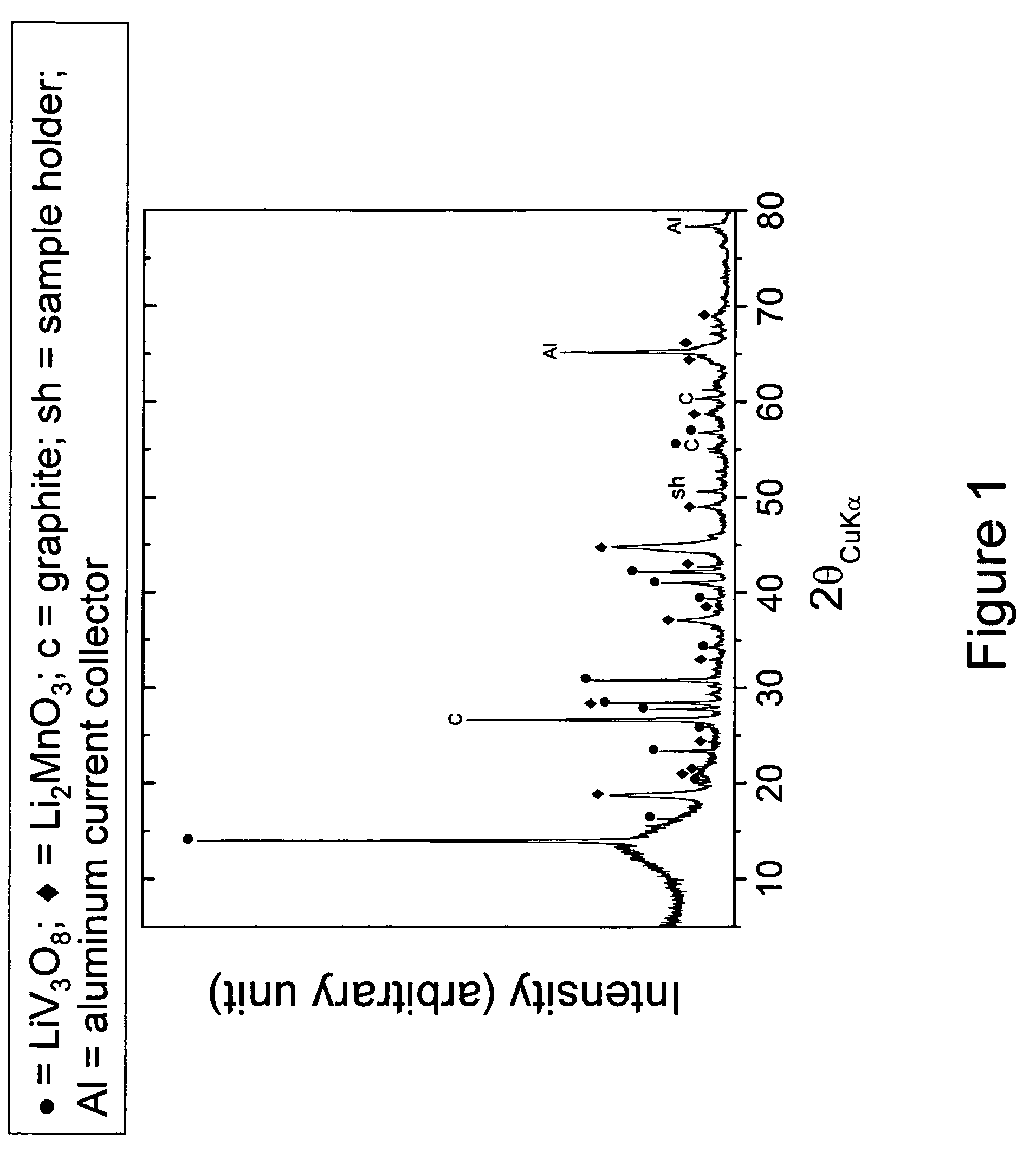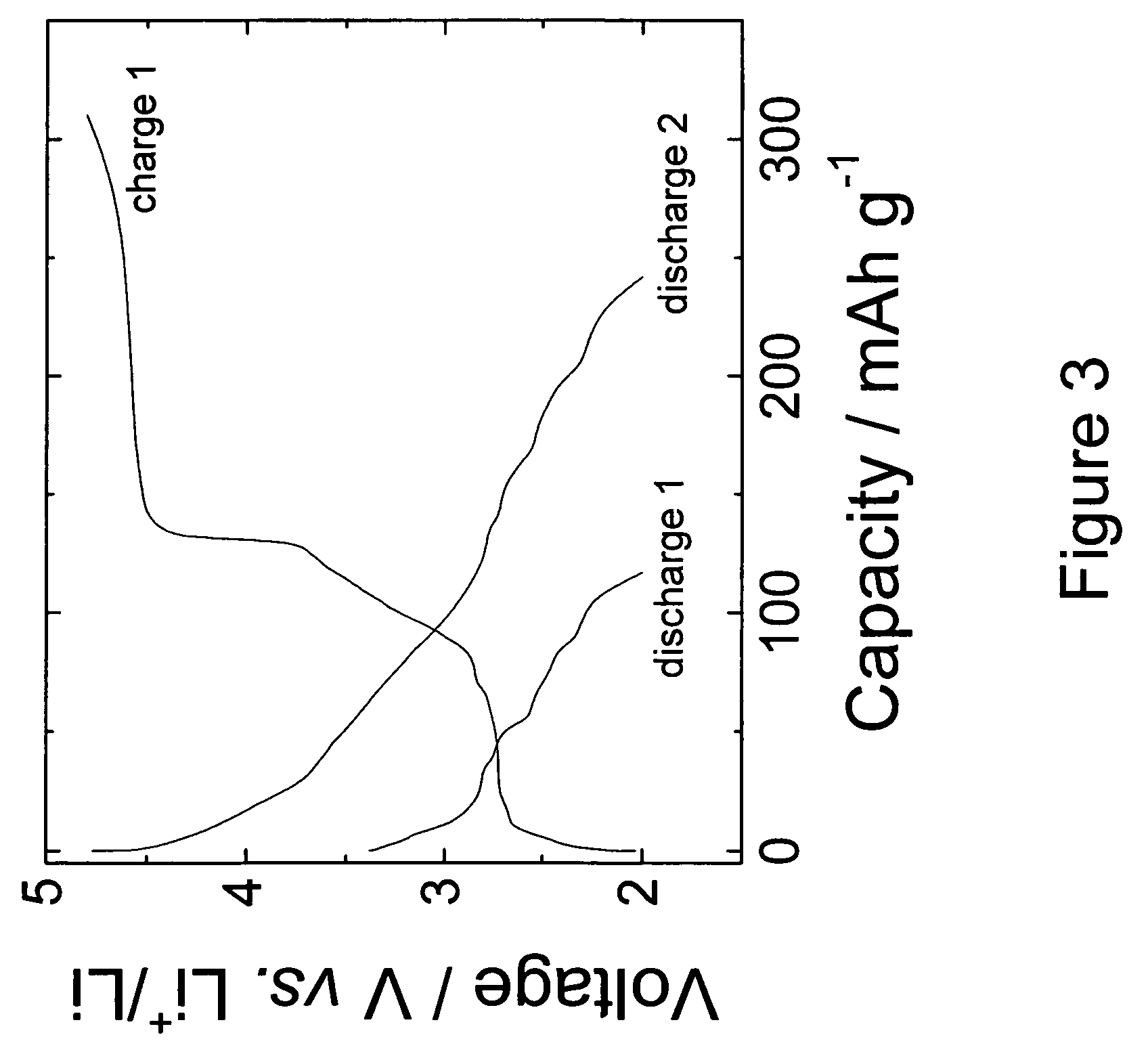Positive electrodes for lithium batteries
a lithium battery and positive electrode technology, applied in the field of positive electrodes, can solve the problems of limited specific and volumetric capacity of electrode materials currently in use for large-scale applications such as electric vehicles and plug-in hybrid electric vehicles, and achieve the effect of improving the specific and volumetric capacity of electrode materials
- Summary
- Abstract
- Description
- Claims
- Application Information
AI Technical Summary
Benefits of technology
Problems solved by technology
Method used
Image
Examples
example 1
[0041]A positive electrode precursor with the nominal composition 0.74Li2MnO3.0.26Li1.2V3O8 was prepared by intimately mixing individually-prepared Li2MnO3 and Li1.2V3O8 powders in the desired stoichiometric ratio and subsequently heating the mixture at about 300° C. in air for 24 hours. The Li1.2V3O8 precursor was prepared by mixing Li2CO3 and NH4VO3 powders and thereafter calcining them at about 450° C. for 48 hours in air. The Li2MnO3 precursor sample was prepared by mixing and calcining Li2CO3 and MnCO3 powders under the same preparative conditions as the Li1.2V3O8 sample. The X-ray diffraction pattern of the 0.74Li2MnO3.0.26Li1.2V3O8 product is shown in FIG. 1.
[0042]Electrochemical tests of the 0.74Li2MnO3.0.26Li1.2V3O8 electrodes were conducted in lithium ‘half’ cells as follows. The electrodes for each lithium cell were fabricated from a mixture of 84 wt % of 0.74Li2MnO3.0.26Li1.2V3O8 electrode powder, 8 wt % polyvinylidene difluoride (PVDF) polymer binder (Kynar, Elf-Atochem...
example 2
[0044]The 0.74Li2MnO3.0.26Li1.2V3O8 electrodes of Example 1 were also evaluated in lithium-ion ‘full’ cells containing MCMB graphitic anodes. Cells were cathode limited. The cells were cycled between 4.7 and 1.0 V at 0.05 mA / cm2. The voltage profiles of the initial charge and subsequent discharge / charge cycles of a typical cell are shown in FIG. 4, which demonstrates the reversibility of the activated 0.74Li2MnO3.0.26Li1.2V3O8 electrodes in a lithium-ion cell configuration. The relatively low rechargeable capacity obtained from the positive electrode (approximately 150 mAh / g) is attributed to the excess MCMB graphite that was used in the unbalanced cell and to the relatively high Li2MnO3 content in the electrode. Improvements in the electrode capacity and cycling efficiency can be expected by increasing the Li1.2V3O8 content in the electrode relative to Li2MnO3, and by balancing the required relative amounts of anode and cathode materials in the lithium-ion cell.
example 3
[0045]In this example, a precursor material, consisting of a Li2O-containing 0.5Li2MnO3.0.5LiNi0.44Co0.25Mn0.31O2 component (Li2MnO3═Li2O.MnO2) and a charged Li1.2V3O8 component in a 0.9:1 molar ratio was evaluated. The 0.9(0.5Li2MnO3.0.5LiNi0.44Co0.25Mn0.31O2).0.1Li1.2V3O8 precursor was prepared by mixing pre-prepared 0.5Li2MnO3.0.5LiNi0.44Co0.25Mn0.31O2 and 0.1Li1.2V3O8 materials in a 0.9:01 stoichiometric ratio and heating them typically at a temperature in the range of about 100° C. to 450° C. for about 12 hours in air. The 0.5Li2MnO3.0.5LiNi0.44Co0.25Mn0.31O2 component was prepared by first intimately mixing Li2CO3 and (Mn0.656Co0.125Ni0.219)(OH)2 powders and, thereafter, calcining the mixture at about 700° C. for about 36 h in air. The Li1.2V3O8 precursor was prepared as described in Example 1. The X-ray diffraction pattern of 0.9(0.5Li2MnO3.0.5LiNi0.44Co0.25Mn0.31O2).0.1Li1.2V3O8 product was consistent with the typical patterns of 0.5Li2MnO3.0.5LiNi0.44Co0.25Mn0.31O2 and Li1....
PUM
 Login to View More
Login to View More Abstract
Description
Claims
Application Information
 Login to View More
Login to View More - R&D
- Intellectual Property
- Life Sciences
- Materials
- Tech Scout
- Unparalleled Data Quality
- Higher Quality Content
- 60% Fewer Hallucinations
Browse by: Latest US Patents, China's latest patents, Technical Efficacy Thesaurus, Application Domain, Technology Topic, Popular Technical Reports.
© 2025 PatSnap. All rights reserved.Legal|Privacy policy|Modern Slavery Act Transparency Statement|Sitemap|About US| Contact US: help@patsnap.com



